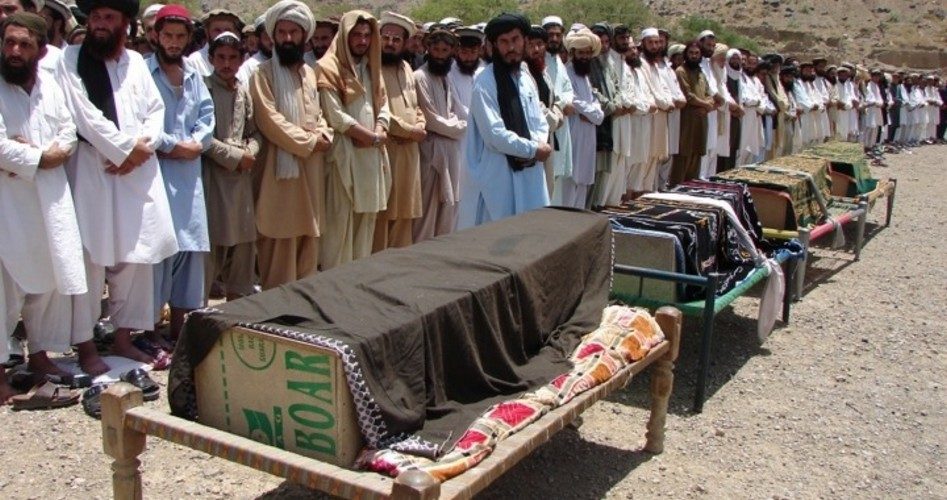
“Not Even the White House Knows the Drones’ Body Count.” We live in a time and place where that is the headline of an article published by a respectable news organization. The information in the article following that headline is no less provocative:
In May, an administration official told The New York Times that civilian casualties from the Pakistan drone war were in the “single digits.” Perhaps that official only meant for one year. Meanwhile, the Bureau of Investigative Journalism estimates the minimum civilian death toll to be 447 during the campaign. One of the many costs of secret wars is that ”nobody knows how many civilians have been killed by covert drone strikes. Nobody — that means the Obama Administration, the Pakistan government, and the media,” emails Sarah Holewinski, the executive director of the Center for Civilians in Conflict.
The uncertainty as to the number of innocent people murdered by U.S. drone attacks and discounted as acceptable collateral damage only cements the certainty of the fact that under President Barack Obama — a Nobel Peace Prize winner — the United States maintains two kill lists from which targets are selected for summary execution at the hands of agents of our government. And they don’t bother counting the corpses.
Beyond the headlines, one of the most disturbing and damning accounts of the effect of the Obama administration’s drone war on the civilian population of Pakistan — the most frequent target of the attacks — was highlighted recently by The New American.
The report entitled “Living Under Drones: Death, Injury and Trauma to Civilians From US Drone Practices in Pakistan” was co-authored by the law schools of Stanford and New York Universities and contains on-the-ground accounts of the myriad ways that President Obama’s drone-delivered program of assassination is devastating the lives of ordinary Pakistanis who have no connection to terror other than the fact that they are being constantly terrorized by the government of the United States.
Glen Greenwald of the Guardian (UK) artfully describes the situation on the ground in Pakistan:
The people in the areas targeted by Obama’s drone campaign are being systematically terrorized. There’s just no other word for it. It is a campaign of terror — highly effective terror — regardless of what noble progressive sentiments one wishes to believe reside in the heart of the leader ordering it. And that’s precisely why the report, to its great credit, uses that term to describe the Obama policy: the drone campaign “terrorizes men, women, and children.”
Twenty-seven pages of the 182-page document is devoted to enumerating the various ways the use of drones in the White House and CIA’s targeted killing programs are rattling the already war-ravaged psyches of the civilian population of Pakistan.
For example, in the subsection entitled “Mental Health Impacts of Drone Strikes and the Presence of Drones,” the authors relate the story of two-time Pulitzer Prize winning reporter David Rohde who was kidnapped in November 2008 and held for seven months by the Taliban while covering Afghanistan and Pakistan for The New York Times in the Federally Administered Tribal Areas (FATA) of northwest Pakistan. Rohde’s story as quoted in the drone report: “The drones were terrifying. From the ground, it is impossible to determine who or what they are tracking as they circle overhead. The buzz of a distant propeller is a constant reminder of imminent death.” Describing the experience of living under drones as ‘hell on earth,’ Rohde explained that even in the areas where strikes were less frequent, the people living there still feared for their lives.
Many in the United States may discount the importance of such a story, pointing out that such an existence is the price of harboring terrorists and those intent on threatening the national security of the United States.
One wonders if that attitude will change in the next couple of years when 30,000 drones fill the skies of the United States. Will we come to know the ever-present sound of a “distant propeller” stirring up the otherwise placid domestic skies with the inimitable buzz of imminent death? Will we live in constant fear of “when is the next drone attack going to happen” as one mental health professional hears daily from the men and women of Waziristan?
One of the most horrifying tactics reportedly used by the United States in the prosecution of the death-by-drone program is the so-called “double tap.” The Stanford/NYU report brought this to light and an article in the Daily Mail (U.K.) accurately summarized the practice: “A drone fires one missile — and then a second as rescuers try to drag victims from the rubble. One aid agency said they had a six-hour delay before going to the scene.” According to the story this insupportable and inhumane tactic is resulting in the death of “49 people for every one known terrorist in Pakistan.”
Often, the story is reported, surviving relatives of those killed by the drone assaults are denied the opportunity to bury their dead and perform the ancient rites associated with placing a body in its final resting place. One man severely injured in a drone attack reports that “people are reluctant to go to the funerals of people who have been killed in drone strikes because they are afraid of being targeted.”
Page 92 of the document recounts interviews of several Pakistanis who were intentionally targeted by the Hellfire missiles fired at funerals. The grief experienced and related by these men is evident, heart-wrenching, and demoralizing.
One man who lost several relatives in a drone strike tells how the dead from that strike were buried: “They held a funeral for everybody, in the same location, one by one. Their bodies were scattered into tiny pieces. They … couldn’t be identified,” said Massod Afwan.
Is this the sort of behavior that qualifies the area and the attendants to be lit up by a “signature strike” — a strike based not on suspicion of guilt, but of a “patter of behavior?”
To put it another way, if your uncle, a notorious and despicable mobster, was laid to rest and you attend his funeral would it be lawful for the FBI to shoot you (and any other members of your family at the gravesite) on the spot for displaying behavior indicative of affiliation with the Mafia or associated forces?
The blame for these most shameful and non-surgical killings is bi-partisan. Republicans and Democrats gave former President George W. Bush the green light to begin the operation in Pakistan after the attacks of September 11, 2001. Then, despite his peace-promoting accolades, President Barack Obama has ratcheted up both the number of drones in the air and the number of bodies in the ground as a result of their use.
An article in USA Today posits that “if President Obama loses in November, drones will be his most dangerous legacy,” noting that information about the program leaked earlier this year indicates that “Obama personally holds the reins on this expansive drone war, and he holds them tightly.”
With all that is left unclear, what the foregoing makes perfectly clear is that the United States no longer has a tight hold on the reins of the Constitution. The bedrock principle of due process has been demolished and in its place a monument to autocratic assassinations is being erected on the rubble.
Photo of funeral in Pakistan for victims of 2011 drone strike: AP Images


